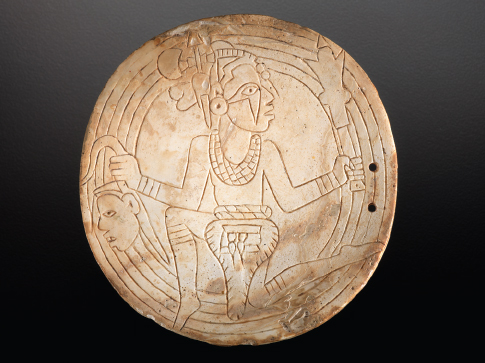America’s History: Printed Page 26
THINKING LIKE A HISTORIAN |  |
Colliding Cultures
Carefully consider each of the objects or texts below. What meanings might you — thinking like a historian — impart to them?
Mississippian warrior gorget (neck guard), A.D. 1250–1350.
 Source: The National Museum of the American Indian/George Gustav Heye Center/New York, NY William E. Meyer Collection 15/853.
Source: The National Museum of the American Indian/George Gustav Heye Center/New York, NY William E. Meyer Collection 15/853.Portuguese officer’s account of de Soto’s expedition, 1557. This excerpt describes Indian resistance in the face of de Soto’s campaign of conquest against Indians in the southeastern United States.
[Spanish soldiers] went over a swampy land where the horsemen could not go. A half league from camp they came upon some Indian huts near the river; [but] the people who were inside them plunged into the river. They captured four Indian women, and twenty Indians came at us and attacked us so stoutly that we had to retreat to the camp, because of their being (as they are) so skillful with their weapons. Those people are so warlike and so quick that they make no account of foot soldiers; for if these go for them, they flee, and when their adversaries turn their backs they are immediately on them. The farthest they flee is the distance of an arrow shot. They are never quiet but always running and crossing from one side to another so that the crossbows or the arquebuses can not be aimed at them; and before a crossbowman can fire a shot, an Indian can shoot three or four arrows, and very seldom does he miss what he shoots at. If the arrow does not find armor, it penetrates as deeply as a crossbow. The bows are very long and the arrows are made of certain reeds like canes, very heavy and so tough that a sharpened cane passes through a shield. Some are pointed with a fish bone, as sharp as an awl, and others with a certain stone like a diamond point.
Duarte Lopez, A Report on the Kingdom of Kongo, 1591. A Portuguese explorer’s account of his travels in southern Africa in the sixteenth century.
[T]he Kingdom of Sofala lies between the two rivers, Magnice and Cuama, on the sea-coast. It is small in size, and has but few villages and towns. … It is peopled by Mohammedans, and the king himself belongs to the same sect. He pays allegiance to the crown of Portugal, in order not to be subject to the government of Monomotapa [Mutapa]. On this account the Portuguese have a fortress at the mouth of the River Cuama, trading with those countries in gold, amber, and ivory, all found on that coast, as well as in slaves, and giving in exchange silk stuffs and taffetas. … It is said, that from these regions the gold was brought by sea which served for Solomon’s Temple at Jerusalem, a fact by no means improbable, for in these countries of Monomotapa are found several ancient buildings of stone, brick, and wood, and of such wonderful workmanship, and architecture, as is nowhere seen in the surrounding provinces.
The Kingdom of Monomotapa is extensive, and has a large population of Pagan heathens, who are black, of middle stature, swift of foot, and in battle fight with great bravery, their weapons being bows and arrows, and light darts. There are numerous kings tributary to Monomotapa, who constantly rebel and wage war against it. The Emperor maintains large armies, which in the provinces are divided into legions, after the manner of the Romans, for, being a great ruler, he must be at constant warfare in order to maintain his dominion. Amongst his warriors, those most renowned for bravery, are the female legions, greatly valued by the Emperor, being the sinews of his military strength.
Benin figurine of a Portuguese soldier from the seventeenth century. This brass figure would have been kept on an altar or on the roof of the royal palace of Benin.
 Source: © The Trustees of the British Museum/Art Resource, NY.
Source: © The Trustees of the British Museum/Art Resource, NY.Sixteenth-century Portuguese coin made from African gold. Before the discovery of the Americas, half of the Old World’s gold came from sub-Saharan Africa.
 Source: © The Trustees of the British Museum/Art Resource, NY.
Source: © The Trustees of the British Museum/Art Resource, NY.Sixteenth- or seventeenth-century Spanish silver real. Spain minted enormous quantities of American silver; much of it was shipped to Manila, where it was exchanged for Asian luxury goods.
 Source: © RMN-Grand Palais/Art Resource, NY.
Source: © RMN-Grand Palais/Art Resource, NY.
Sources: (2) John E. Worth, “Account of the Northern Conquest and Discovery of Hernando de Soto by Rodrigo Rangel,” trans. John E. Worth, in Lawrence A. Clayton et al., eds., The De Soto Chronicles: The Expedition of Hernando de Soto to North America in 1539–1543 (University of Alabama Press, 1993), 59; (3) Filippo Pigafetta, A Report of the Kingdom of Congo, trans. Margarite Hutchinson (London: John Murray, 1881), 117–119.
ANALYZING THE EVIDENCE
Question
What can you infer about cultural values among Mississippian peoples from source 1? About the cultural values of the Spanish and Portuguese from sources 5 and 6? What can’t you infer from these objects?
Question
How does de Soto describe the native peoples he encounters in Florida (source 2)? How does that compare to the traits of the African kingdoms that Lopez comments upon in source 3? Why might the king of Sofala prefer a Portuguese alliance to subjection to Monomotapa?
Question
What does source 4 suggest about Benin relations with the Portuguese?
PUTTING IT ALL TOGETHER
Question
What do these sources tell us about the ways Native Americans, Europeans, and Africans thought about themselves, perceived one another, and capitalized on cross-cultural exchanges as they came into sustained contact? Write a short essay that considers the connection between the impulses of warfare and commerce, which appear again and again in contact settings.